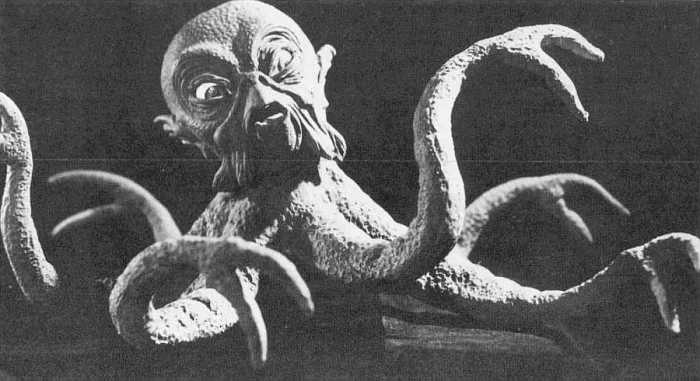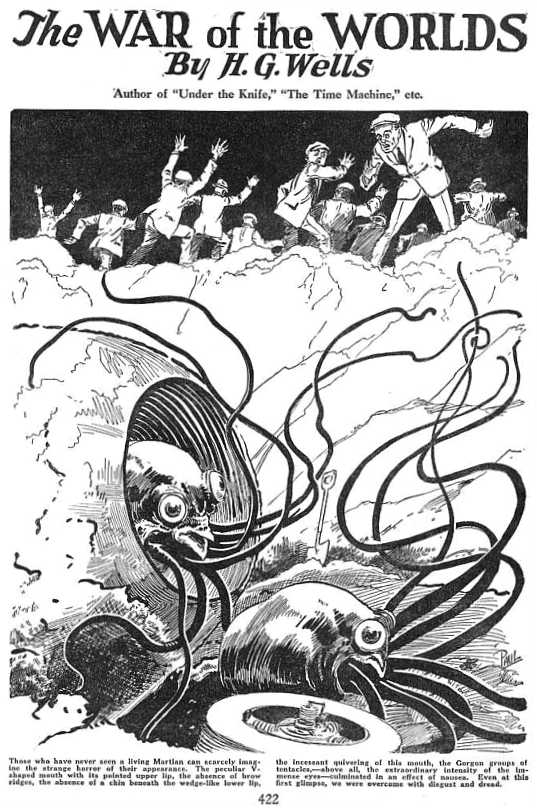There was a charmingly naive fascination with
life on Mars around 1900 (and on the moon about 70 years previously). Not only was Lowell
mapping the "canals" of Mars and telling stories of a threatened civilization
trying to husband water for its dying crops, but others suggested possible means of
communication, within the technological capabilities of the time:
The earliest speculations about communication with extraterrestrial intelligence
(ETI) involved contact with the Moon and with other planets of our own solar system. In
the 1800s, many astronomers thought that — at least theoretically — life might
well exist throughout the solar system. But when people raised the question of whether we
are really alone in the solar system, they began to imagine ways to find a very concrete
answer.

Since it was still impossible to travel to other planets in the early 19th century, other
methods not requiring face-to-face contact were suggested to answer the question "Is
anyone out there?" For example, in the 1820s, one mathematician proposed that we
could signal any inhabitants of the Moon by clearing massive stretches of forest in
Siberia. In this plan, the forests would be cut down so that any beings viewing Siberia
from the Moon would see a geometry lesson carved on the surface of the Earth. Surely, it
was argued, a huge diagram of the Pythagorean theorem would tell any intelligent beings on
the Moon that their next door neighbors have a basic grasp of mathematics.

Others suggested that we could use the same approach, even when the dark side of the Earth
faced the Moon. In this case, huge canals might be dug out of the Sahara Desert, perhaps
in the shape of a circle. When filled with kerosene and lit while it was nighttime in the
Sahara, this signal would suggest to the Moon-folk that Earthlings have an appreciation
for geometry and enough practice with pyrotechnics to get a good bonfire going.
(From Douglas Vakoch, http://www.seti.org/science/signals.html)
In 1895 a professor of astronomy, Samual Leland
Phelps, wrote in a book called "World Making" that with a new 40 inch telescope
being built by the University of Chicago,
"It will be possible to see cities on Mars, to detect navies in [its]
harbors, and the smoke of great manufacturing cities and towns... Is Mars inhabited? There
can be little doubt of it ... conditions are all favorable for life, and life, too, of a
high order. Is it possible to know this of a certainty? Certainly." (quoted in Feb.,
1973 National Geographic)
http://csep10.phys.utk.edu/astr161/lect/mars/mars.html
H. G. Wells wrote "The War of the
Worlds" in 1898, which describes the invasion of Earth by Martians. This story gained
great notoriety in 1938 when a radio reading was interpreted by many as a genuine news
broadcast, and people assumed that Martians had really invaded! It is probably the most
influential science fiction story ever written, forming the common impression of
intelligent life on Mars for decades. Now, Steven Spielberg has made a new movie based on
the same story, starring Tom Cruise and unfortunately only receiving mixed reviews. Here
is an excerpt from the original:
Then came the night of the first falling star. It was seen early in the morning,
rushing over Winchester eastward, a line of flame high in the atmosphere. Hundreds must
have seen it, and taken it for an ordinary falling star. Albin described it as leaving a
greenish streak behind it that glowed for some seconds. Denning, our greatest authority on
meteorites, stated that the height of its first appearance was about ninety or one hundred
miles. It seemed to him that it fell to earth about one hundred miles east of him.
I was at home at that hour and writing in my study; and although my French windows face
towards Ottershaw and the blind was up (for I loved in those days to look up at the night
sky), I saw nothing of it. Yet this strangest of all things that ever came to earth from
outer space must have fallen while I was sitting there, visible to me had I only looked up
as it passed. Some of those who saw its flight say it travelled with a hissing sound. I
myself heard nothing of that. Many people in Berkshire, Surrey, and Middlesex must have
seen the fall of it, and, at most, have thought that another meteorite had descended. No
one seems to have troubled to look for the fallen mass that night.
But very early in the morning poor Ogilvy, who had seen the shooting star and who was
persuaded that a meteorite lay somewhere on the common between Horsell, Ottershaw, and
Woking, rose early with the idea of finding it. Find it he did, soon after dawn, and not
far from the sand pits. An enormous hole had been made by the impact of the projectile,
and the sand and gravel had been flung violently in every direction over the heath,
forming heaps visible a mile and a half away. The heather was on fire eastward, and a thin
blue smoke rose against the dawn.
The Thing itself lay almost entirely buried in sand, amidst the scattered splinters of
a fir tree it had shivered to fragments in its descent. The uncovered part had the
appearance of a huge cylinder, caked over and its outline softened by a thick scaly
dun-coloured incrustation. It had a diameter of about thirty yards. He approached the
mass, surprised at the size and more so at the shape, since most meteorites are rounded
more or less completely. It was, however, still so hot from its flight through the air as
to forbid his near approach. A stirring noise within its cylinder he ascribed to the
unequal cooling of its surface; for at that time it had not occurred to him that it might
be hollow.....
And then he perceived that, very slowly, the circular top of the cylinder was rotating on
its body. It was such a gradual movement that he discovered it only through noticing that
a black mark that had been near him five minutes ago was now at the other side of the
circumference. Even then he scarcely understood what this indicated, until he heard a
muffled grating sound and saw the black mark jerk forward an inch or so. Then the thing
came upon him in a flash. The cylinder was artificial--hollow--with an end that screwed
out! Something within the cylinder was unscrewing the top!
........By eight o'clock a number of boys and unemployed men had already started for
the common to see the "dead men from Mars." That was the form the story took. I
heard of it first from my newspaper boy about a quarter to nine when I went out to get my
DAILY CHRONICLE. I was naturally startled, and lost no time in going out and across the
Ottershaw bridge to the sand pits......
Going to the edge of the pit, I found it occupied by a group of about half a dozen
men--Henderson, Ogilvy, and a tall, fair-haired man that I afterwards learned was Stent,
the Astronomer Royal, with several workmen wielding spades and pickaxes. Stent was giving
directions in a clear, high-pitched voice. He was standing on the cylinder, which was now
evidently much cooler; his face was crimson and streaming with perspiration, and something
seemed to have irritated him.
A large portion of the cylinder had been uncovered, though its lower end was still
embedded. As soon as Ogilvy saw me among the staring crowd on the edge of the pit he
called to me to come down, and asked me if I would mind going over to see Lord Hilton, the
lord of the manor.
The growing crowd, he said, was becoming a serious impediment to their excavations,
especially the boys. They wanted a light railing put up, and help to keep the people back.
He told me that a faint stirring was occasionally still audible within the case, but that
the workmen had failed to unscrew the top, as it afforded no grip to them. The case
appeared to be enormously thick, and it was possible that the faint sounds we heard
represented a noisy tumult in the interior.......
The end of the cylinder was being screwed out from within. Nearly two feet of shining
screw projected. Somebody blundered against me, and I narrowly missed being pitched onto
the top of the screw. I turned, and as I did so the screw must have come out, for the lid
of the cylinder fell upon the gravel with a ringing concussion. I stuck my elbow into the
person behind me, and turned my head towards the Thing again. For a moment that circular
cavity seemed perfectly black. I had the sunset in my eyes.
I think everyone expected to see a man emerge--possibly something a little unlike us
terrestrial men, but in all essentials a man. I know I did. But, looking, I presently saw
something stirring within the shadow: greyish billowy movements, one above another, and
then two luminous disks--like eyes. Then something resembling a little grey snake, about
the thickness of a walking stick, coiled up out of the writhing middle, and wriggled in
the air towards me--and then another.
A sudden chill came over me. There was a loud shriek from a woman behind. I half turned,
keeping my eyes fixed upon the cylinder still, from which other tentacles were now
projecting, and began pushing my way back from the edge of the pit. I saw astonishment
giving place to horror on the faces of the people about me. I heard inarticulate
exclamations on all sides. There was a general movement backwards. I saw the shopman
struggling still on the edge of the pit. I found myself alone, and saw the people on the
other side of the pit running off, Stent among them. I looked again at the cylinder, and
ungovernable terror gripped me. I stood petrified and staring.
 |
| A sculpture of a Martian by stop-motion guru Ray Harryhausen, created for
a test reel that he tried to pitch to RKO in 1949. From Cinefantastique, Volume 11, Number
4 (December 1981). Courtesy of Rick Pearson. http://drzeus.best.vwh.net/wotw/other/other.html |
A big greyish rounded bulk, the size, perhaps, of a bear, was rising slowly and painfully
out of the cylinder. As it bulged up and caught the light, it glistened like wet leather.
Two large dark-coloured eyes were regarding me steadfastly. The mass that framed them, the
head of the thing, was rounded, and had, one might say, a face. There was a mouth under
the eyes, the lipless brim of which quivered and panted, and dropped saliva. The whole
creature heaved and pulsated convulsively. A lank tentacular appendage gripped the edge of
the cylinder, another swayed in the air. ...... to be continued
To read more, http://www.gutenberg.org/etext/36,
or follow this link




